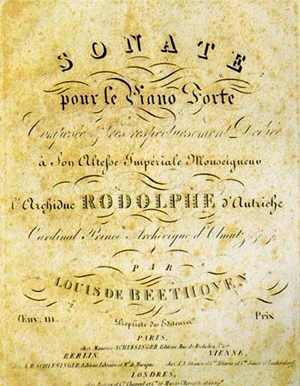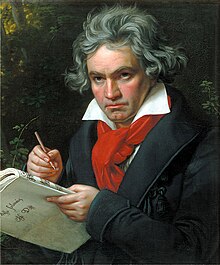
The Piano Sonata No. 14 in C-sharp minor, marked Quasi una fantasia, Op. 27, No. 2, is a piano sonata by Ludwig van Beethoven, completed in 1801 and dedicated in 1802 to his pupil Countess Julie "Giulietta" Guicciardi. Although known throughout the world as the Moonlight Sonata, it was not Beethoven who named it so. The name grew popular later, likely long after Beethoven's death.

Ludwig van Beethoven's Piano Sonata No. 29 in B♭ major, Op. 106 is a piano sonata that is widely viewed as one of the most important works of the composer's third period and among the greatest piano sonatas of all time. Completed in 1818, it is often considered to be Beethoven's most technically challenging piano composition and one of the most demanding solo works in the classical piano repertoire. The first documented public performance was in 1836 by Franz Liszt in the Salle Erard in Paris to an enthusiastic review by Hector Berlioz.

Beethoven's Piano Sonata No. 21 in C major, Op. 53, known as the Waldstein, is one of the three most notable sonatas of his middle period. Completed in summer 1804 and surpassing Beethoven's previous piano sonatas in its scope, the Waldstein is a key early work of Beethoven's "Heroic" decade (1803–1812) and set a standard for piano composition in the grand manner.

The Piano Sonata No. 32 in C minor, Op. 111, is the last of Ludwig van Beethoven's piano sonatas. The work was written between 1821 and 1822. Like other late period sonatas, it contains fugal elements. It was dedicated to his friend, pupil, and patron, Archduke Rudolf.

Ludwig van Beethoven completed his String Quartet No. 12 in E♭ major, Op. 127, in 1825. It is the first of his late quartets. Commissioned by Nicolas Galitzin over a year earlier, the work was not ready when it was scheduled to premiere. When it finally premiered by the Schuppanzigh Quartet, it was not well received. Only with subsequent performances by the Bohm Quartet and the Mayseder Quartet did it begin to gain public appreciation.

The Violin Sonata No. 9 in A major, Op. 47, by Ludwig van Beethoven, is an 1803 sonata for piano and violin notable for its technical difficulty, unusual length, and emotional scope. It is commonly known as the Kreutzer Sonata after the violinist Rodolphe Kreutzer, to whom it was ultimately dedicated, but who thoroughly disliked the piece and refused to play it.

The Cello Sonata No. 3 in A major, Op. 69, is the third of five cello sonatas by Ludwig van Beethoven. He composed it in 1807–08, during his productive middle period. It was first performed in 1809 by cellist Nikolaus Kraft and pianist Dorothea von Ertmann, a student of Beethoven. Published by Breitkopf & Härtel the same year, it was dedicated to Freiherr Ignaz von Gleichenstein, Beethoven's friend and an amateur cellist. The sonata was successful with audiences from the beginning.

Ludwig van Beethoven composed his Piano Sonata No. 12 in A♭ major, Op. 26, in 1800–1801, around the same time as he completed his First Symphony. He dedicated the sonata to Prince Karl von Lichnowsky, who had been his patron since 1792.

Ludwig van Beethoven's Piano Sonata No. 16 in G major, Op. 31, No. 1, was composed between 1801 and 1802. Although it was numbered as the first piece in the trio of piano sonatas which were published as Opus 31 in 1803, Beethoven actually finished it after the Op. 31 No. 2, the Tempest Sonata.

Ludwig van Beethoven's Piano Sonata No. 5 in C minor, Op. 10, No. 1 was composed some time during 1796–98.
Piano Sonata No. 15 in D major, Op. 28, is a piano sonata by Ludwig van Beethoven. The name Pastoral or Pastorale became known through A. Cranz publishing of Beethoven's work, but was first coined by a London publisher, Broderip & Wilkinson. While not as famous as its immediate predecessor, Piano Sonata No. 14, it is generally admired for its intricate technicality as well as for its beauty. The sonata takes roughly twenty-five minutes to play with its intended repeats.

The Piano Sonata No. 25 in G major, Op. 79, was composed by Ludwig van Beethoven in 1809. It is alternatively titled "Cuckoo" or "Sonatina," and it is notable for its shortness. A typical performance lasts only about nine minutes. The work is in three movements: a fast-paced Presto alla tedesca, a slower Andante, and a lively Vivace.

Ludwig van Beethoven's Piano Sonata No. 1 in F minor, Op. 2 No. 1, was written in 1795 and dedicated to Joseph Haydn. It was published simultaneously with his second and third piano sonatas in 1796.

Piano Sonata No. 13 in E-flat major, Op. 27 No. 1, "Quasi una fantasia", is a sonata composed by Ludwig van Beethoven in 1800–1801.

The Piano Sonata No. 24 in F♯ major, Op. 78, nicknamed "à Thérèse" was written by Ludwig van Beethoven in 1809. It consists of two movements:

The Piano Sonata No. 28 in A major, Op. 101, by Ludwig van Beethoven was composed in 1816 and published in 1817. Dedicated to the pianist Baroness Dorothea Ertmann, née Graumen, it is considered the first of the composer's late piano sonatas.
In western classical music, the sonata cycle is a multi-movement structure used in a concerto, symphony or sonata.

Franz Schubert's last three piano sonatas, D 958, 959 and 960, are his last major compositions for solo piano. They were written during the last months of his life, between the spring and autumn of 1828, but were not published until about ten years after his death, in 1838–39. Like the rest of Schubert's piano sonatas, they were mostly neglected in the 19th century. By the late 20th century, however, public and critical opinion had changed, and these sonatas are now considered among the most important of the composer's mature masterpieces. They are part of the core piano repertoire, appearing regularly on concert programs and recordings.
The Sonatas for cello and piano No. 4 in C major, Op. 102, No. 1, and No. 5 in D major, Op. 102, No. 2, by Ludwig van Beethoven were composed simultaneously in 1815 and published, by Simrock, in 1817 with a dedication to the Countess Marie von Erdődy, a close friend and confidante of Beethoven.

The Piano Quartets, WoO 36, by Ludwig van Beethoven are a set of three piano quartets, completed in 1785 when the composer was aged 14. They are scored for piano, violin, viola and cello. He composed a quartet in C major, another in E-flat major, and a third in D major. They were first published posthumously in 1828, however numbered in a different order: Piano Quartet No. 1 in E-flat major, Piano Quartet No. 2 in D major, and Piano Quartet No. 3 in C major.



















